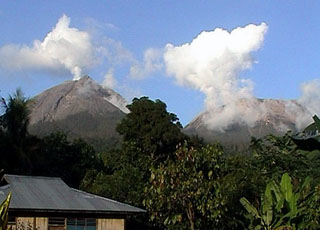Report on Lewotobi (Indonesia) — 16 April-22 April 2025
Smithsonian Institution / US Geological Survey
Weekly Volcanic Activity Report, 16 April-22 April 2025
Managing Editor: Sally Sennert.
Please cite this report as:
Global Volcanism Program, 2025. Report on Lewotobi (Indonesia) (Sennert, S, ed.). Weekly Volcanic Activity Report, 16 April-22 April 2025. Smithsonian Institution and US Geological Survey.
Lewotobi
Indonesia
8.542°S, 122.775°E; summit elev. 1703 m
All times are local (unless otherwise noted)
The Pusat Vulkanologi dan Mitigasi Bencana Geologi (PVMBG) reported that eruptive activity at Lewotobi Laki-laki continued during 16-22 April. Dense gray ash plumes rose 2.5-3.5 km above the summit on 16 April and drifted multiple directions. Ash plumes during 17-18 April rose 500-700 m above the summit and drifted mainly N and NE; weather clouds sometimes obscured views. Multiple ash plumes per day were recorded during 19-22 April. Ash plumes rose as high as 3 km and drifted in multiple directions. An eruptive event that was recorded at 2359 on 20 April ejected incandescent material onto the upper flanks. According to a news report, the event was accompanied by a loud banging sound heard at the Lewotobi Laki-laki observation post, 4.9 km WSW. On 22 April ash-and-gas plumes were continuously emitted from approximately 1000 at least through 1554; dense gray ash plumes rose 1.3-1.5 km above the summit and drifted W and NW, though weather clouds sometimes obscured views. The Alert Level remained at 3 (on a scale of 1-4) and the public was warned to stay 6 km away from the center of Laki-laki.
Geological Summary. The Lewotobi edifice in eastern Flores Island is composed of the two adjacent Lewotobi Laki-laki and Lewotobi Perempuan stratovolcanoes (the "husband and wife"). Their summits are less than 2 km apart along a NW-SE line. The conical Laki-laki to the NW has been frequently active during the 19th and 20th centuries, while the taller and broader Perempuan has had observed eruptions in 1921 and 1935. Small lava domes have grown during the 20th century in both of the summit craters, which are open to the north. A prominent cone, Iliwokar, occurs on the E flank of Perampuan.
Sources: Pusat Vulkanologi dan Mitigasi Bencana Geologi (PVMBG, also known as CVGHM), Antara News

